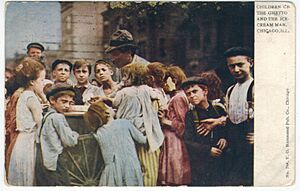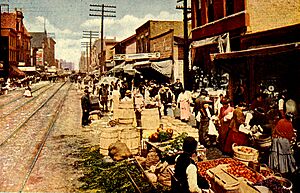Ghetto facts for kids
A ghetto is a part of a city in which members of a minority group are concentrated, especially as a result of political, social, legal, religious, environmental or economic pressure. Ghettos are often known for being more impoverished than other areas of the city. Versions of such restricted areas have been found across the world, each with their own names, classifications, and groupings of people.
The term was originally used for the Venetian Ghetto in Venice, Italy, as early as 1516, to describe the part of the city where Jewish people were restricted to live and thus segregated from other people. However, other early societies may have formed their own versions of the same structure; words resembling ghetto in meaning appear in Hebrew, Yiddish, Italian, Germanic, Old French, and Latin.
The term ghetto acquired deep cultural meaning in the United States, especially in the context of segregation and civil rights. It has been widely used in the country since the 20th century to refer to poor neighborhoods of largely minority populations. It is also used in some European countries, such as Romania and Slovakia, to refer to poor neighborhoods.
United States


The development of ghettos in the United States is closely associated with different waves of immigration and internal urban migration. The Irish and German immigrants of the mid-19th century were the first ethnic groups to form ethnic enclaves in United States cities. This was followed by large numbers of immigrants from Southern and Eastern Europe, including many Italians and Poles and Russians between 1880 and 1920. Jewish immigrants were part of the earliest German wave, as well as comprising numerous immigrants from Eastern Europe, the Russian Empire at the time. Most remained in their established immigrant communities, but by the second or third generation, many families were able to relocate to newer housing built in the suburbs after World War II.
These ethnic ghetto areas included the Lower East Side in Manhattan, New York, which later became notable as predominantly Jewish, and later still as Chinese and Latino. East Harlem was once predominantly Italian and in the 1950s became home to a large Puerto Rican community. Little Italys across the country were predominantly Italian ghettos. Many Polish immigrants settled in areas of other nationals, such as Pilsen of Chicago and Polish Hill of Pittsburgh. Since the late 20th century, Brighton Beach in Brooklyn has become the home of predominately Jewish Russian and Ukrainian immigrants, who left after the Soviet Union lifted some migration restrictions and later after its fall.
Modern usage and reinterpretations of "ghetto"
Recently the word "ghetto" has been used in slang as an adjective rather than a noun. It is used to indicate an object's relation to the inner city and also more broadly to denote something that is shabby or of low quality.
Images for kids
-
Plan of Jewish ghetto, Frankfurt, 1628
-
Chicago ghetto on the South Side, May 1974
See also
 In Spanish: Gueto para niños
In Spanish: Gueto para niños








